

The gist of things here in my hometown, set within the arcs of things in the wider world, all from my uniquely biased point of view. Feel free to extend the horizons with your comments.


 Light and shadow.
Light and shadow.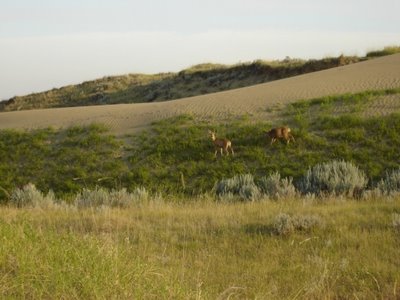 Mule deer on a dune partially revegetated with lance-leaved psoralea or scurf-pea (Psoralea lanceolata)
Mule deer on a dune partially revegetated with lance-leaved psoralea or scurf-pea (Psoralea lanceolata)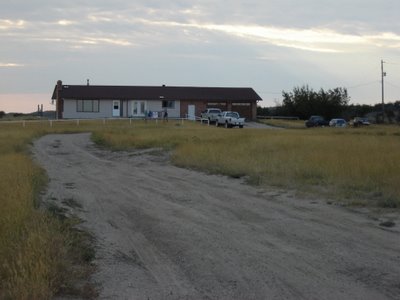
 I took the last available bedroom. Hmmm - am I going to like this? Maybe once I take over the bed.
I took the last available bedroom. Hmmm - am I going to like this? Maybe once I take over the bed.
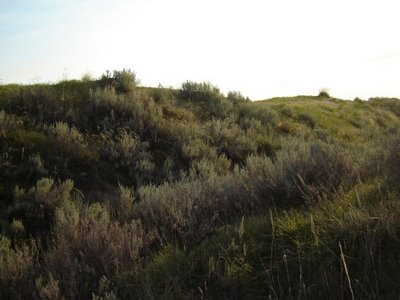
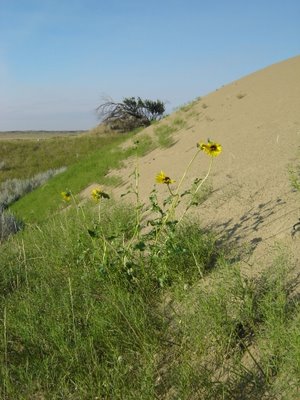
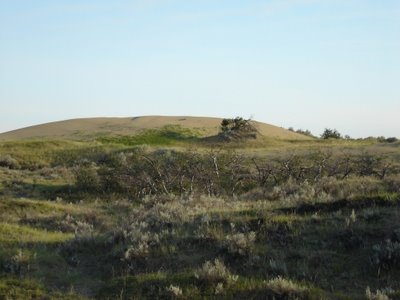


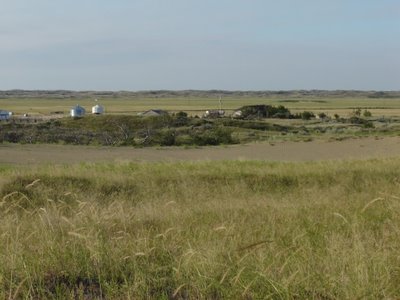 I noticed a lot of terrain like this, where there is a low flat, bordered by higher, very rough land, known as "choppy dune." The ranch buildings seem to huddle at the edge of the flat, taking shelter from the sand ridges but staying out of them. The loneliness of the place was very appealing to me, as long as I didn't start thinking about what it would take to survive there, independently.
I noticed a lot of terrain like this, where there is a low flat, bordered by higher, very rough land, known as "choppy dune." The ranch buildings seem to huddle at the edge of the flat, taking shelter from the sand ridges but staying out of them. The loneliness of the place was very appealing to me, as long as I didn't start thinking about what it would take to survive there, independently.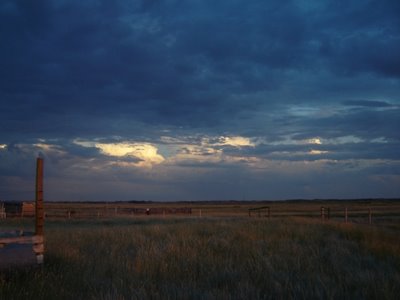


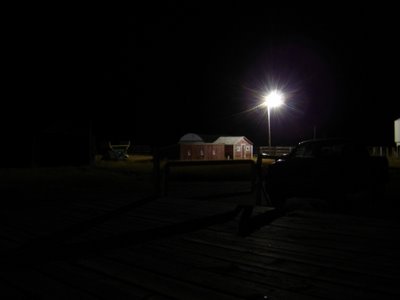
 I see a glint on the horse trailers. Nothing more. No distant traffic, or yard lights, or glow from a town - nothing. Just the dark of the sandhill night.
I see a glint on the horse trailers. Nothing more. No distant traffic, or yard lights, or glow from a town - nothing. Just the dark of the sandhill night.
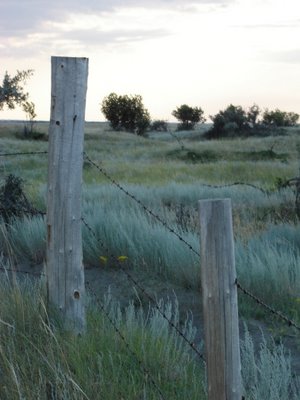

 Taking a cue from Madcap Mum, for comparison purposes: here are some views from just outside the farm gate.
Taking a cue from Madcap Mum, for comparison purposes: here are some views from just outside the farm gate. I took this view for granted.
I took this view for granted.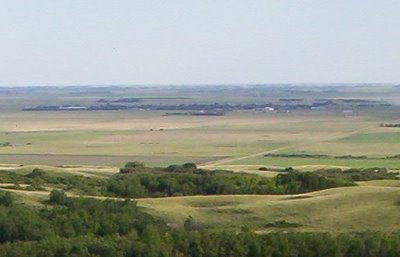 It's just that band of dark green with some buildings showing in it, stretching across most of the width of this view of the distant "flats." I sometimes worry if I'll offend someone by saying "the flats," but our Arcola-Kisbey history book is subtitled "Mountain Hills to Prairie Flats," so I guess it's okay.
It's just that band of dark green with some buildings showing in it, stretching across most of the width of this view of the distant "flats." I sometimes worry if I'll offend someone by saying "the flats," but our Arcola-Kisbey history book is subtitled "Mountain Hills to Prairie Flats," so I guess it's okay. And if you're thinking that's not steep, try climbing it. Or try browsing through some pictures of foothills. Most of the steeper slopes that you see are supported by rock formations. This is just glacial till. Here is a view of the "South Slopes" from the meadow below, looking west across their face.
And if you're thinking that's not steep, try climbing it. Or try browsing through some pictures of foothills. Most of the steeper slopes that you see are supported by rock formations. This is just glacial till. Here is a view of the "South Slopes" from the meadow below, looking west across their face.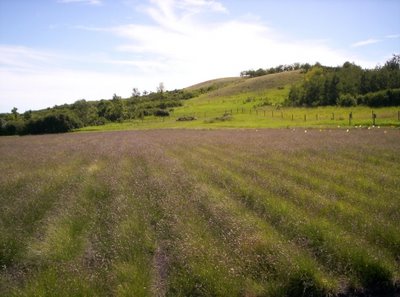 If geology and ecology and botany bore you, skip along to some more pictures below.
If geology and ecology and botany bore you, skip along to some more pictures below. And on the other side of the meadow, south of those "South Slopes," we have "The Big Woods."
And on the other side of the meadow, south of those "South Slopes," we have "The Big Woods." It's not the deepest, darkest view I could get, that's for sure. I love to thread my way through the bush and peer through beneath the understory for tiny flowers and mushrooms and such, but when it comes to taking pictures, I'm always drawn to the light. Besides, I was in the perpetual hurry that seems to haunt me these days, so I mostly kept to the not-so-natural trails.
It's not the deepest, darkest view I could get, that's for sure. I love to thread my way through the bush and peer through beneath the understory for tiny flowers and mushrooms and such, but when it comes to taking pictures, I'm always drawn to the light. Besides, I was in the perpetual hurry that seems to haunt me these days, so I mostly kept to the not-so-natural trails. The cattle had just been put into this pasture the day I rambled through it, so they hadn't grazed and trampled out the trails yet. Give them a few days. Then you can breeze through without having to dodge the stinging nettles, and maybe come away with only a couple of woodticks.
The cattle had just been put into this pasture the day I rambled through it, so they hadn't grazed and trampled out the trails yet. Give them a few days. Then you can breeze through without having to dodge the stinging nettles, and maybe come away with only a couple of woodticks. This is a view from the upper slope of a ravine at the west end of the "South Slopes." I didn't go down to the bottom. You can see a little bit into the shadows, but we're looking mostly at the crowns of the trees. The ravines are a different world. If it's hard work climbing the South Slopes, it's an ordeal climbing straight up through the tangle of thick underbrush on the side of one of these ravines. I've only done it a few times. Usually I seek out a good path before I start up. There is always a path along the bottom, where the cattle and deer and elk and moose follow the way of least resistance. There is good grazing and browsing there, too, even when the hills are dry, and in some of the deeper places there are springs.
This is a view from the upper slope of a ravine at the west end of the "South Slopes." I didn't go down to the bottom. You can see a little bit into the shadows, but we're looking mostly at the crowns of the trees. The ravines are a different world. If it's hard work climbing the South Slopes, it's an ordeal climbing straight up through the tangle of thick underbrush on the side of one of these ravines. I've only done it a few times. Usually I seek out a good path before I start up. There is always a path along the bottom, where the cattle and deer and elk and moose follow the way of least resistance. There is good grazing and browsing there, too, even when the hills are dry, and in some of the deeper places there are springs. Back up at the top of that slope, looking southwest, you can see the ravine running away through the center of the photo towards the flats. In the middle distance at the right side of the photo, you can see an area of more uniform grass cover. Again, it's an old field, now in tame pasture. Notice the contrast with the more diverse vegetation east of the ravine.
Back up at the top of that slope, looking southwest, you can see the ravine running away through the center of the photo towards the flats. In the middle distance at the right side of the photo, you can see an area of more uniform grass cover. Again, it's an old field, now in tame pasture. Notice the contrast with the more diverse vegetation east of the ravine. Oh, I still have more pictures, but it's time to go.
Oh, I still have more pictures, but it's time to go.
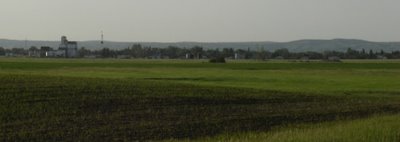
 This is almost straight north of Arcola, about five miles out of town. Arcola is just outside the left edge of the picture, on the plains that you see in the distance.
This is almost straight north of Arcola, about five miles out of town. Arcola is just outside the left edge of the picture, on the plains that you see in the distance.
